LG LH T6540, LH-T6545 Service Manual

[CONTENTS]
SECTION 1.GENERAL
• SERVICING PRECAUTIONS . . . . . . . . . . . . . . . . . . . . . . . . . . . . . . . . . . . . . . . . . . . . . . . |
1-2 |
• ESD PRECAUTIONS . . . . . . . . . . . . . . . . . . . . . . . . . . . . . . . . . . . . . . . . . . . . . . . . . . . . . |
1-4 |
• SPECIFICATIONS . . . . . . . . . . . . . . . . . . . . . . . . . . . . . . . . . . . . . . . . . . . . . . . . . . . . . . . |
.1-5 |
• AUDIO PART ELECTRICAL TROUBLESHOOTINGGUIDE . . . . . . . . . . . . . . . . . . . . . . . . . . |
1-6 |
SECTION 2. AUDIO PART
• ELECTRICAL TROUBLESHOOTING GUIDE . . . . . . . . . . . . . . . . . . . . . . . . . . . . . . . . . . . . 2-1
• BLOCK DIAGRAM . . . . . . . . . . . . . . . . . . . . . . . . . . . . . . . . . . . . . . . . . . . . . . . . . . . . . . . . 2-5
• SCHEMATIC DIAGRAMS . . . . . . . . . . . . . . . . . . . . . . . . . . . . . . . . . . . . . . . . . . . . . . . . . . 2-6
• WIRNG DIAGRAMS . . . . . . . . . . . . . . . . . . . . . . . . . . . . . . . . . . . . . . . . . . . . . . . . . . . . . 2-21
• PRINTED CIRCUIT DIARGAMS . . . . . . . . . . . . . . . . . . . . . . . . . . . . . . . . . . . . . . . . . . . . 2-23
SECTION 3.DVD PART
• DVD PART ELECTRICAL TROUBLESHOOTING GUIDE . . . . . . . . . . . . . . . . . . . . . . . . . . . |
.3-1 |
• DETAILS AND WAVEFORMS ON SYSTEM TEST AND DEBUGGING . . . . . . . . . . . . . . . . |
.3-8 |
• DVD PART SCHEMATIC DIAGRAMS . . . . . . . . . . . . . . . . . . . . . . . . . . . . . . . . . . . . . . . . . |
3-21 |
• VOLTAGE SHEET (IC &TR) . . . . . . . . . . . . . . . . . . . . . . . . . . . . . . . . . . . . . . . . . . . . . . . . |
3-25 |
SECTION 4. EXPLODED VIEWS . . . . . . . . . . . . . . . . . . . . . . . . . . . . . . . . . . .4-1
SECTION 5. SPEAKER PART . . . . . . . . . . . . . . . . . . . . . . . . . . . . . . . . . . . . .5-1
SECTION 6. REPLACEMENT PARTS LIST . . . . . . . . . . . . . . . . . . . . . . . . . . . |
6-1 |
- 1-1 -
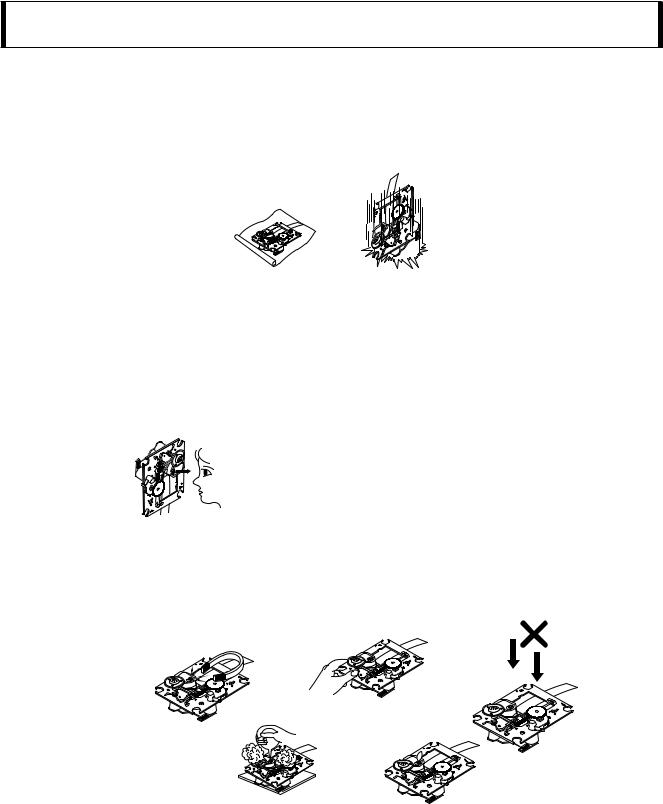
SECTION 1. GENERAL
SERVICING PRECAUTIONS
NOTES REGARDING HANDLING OF THE PICK-UP
1.Notes for transport and storage
1)The pick-up should always be left in its conductive bag until immediately prior to use.
2)The pick-up should never be subjected to external pressure or impact.
Storage in conductive bag |
Drop impact |
2.Repair notes
1)The pick-up incorporates a strong magnet, and so should never be brought close to magnetic materials.
2)The pick-up should always be handled correctly and carefully, taking care to avoid external pressure and impact. If it is subjected to strong pressure or impact, the result may be an operational malfunction and/or damage to the printed-circuit board.
3)Each and every pick-up is already individually adjusted to a high degree of precision, and for that reason the adjustment point and installation screws should absolutely never be touched.
4)Laser beams may damage the eyes!
Absolutely never permit laser beams to enter the eyes!
Also NEVER switch ON the power to the laser output part (lens, etc.) of the pick-up if it is damaged.
NEVER look directly at the laser beam, and don’t let contact fingers or other exposed skin.
5)Cleaning the lens surface
If there is dust on the lens surface, the dust should be cleaned away by using an air bush (such as used for camera lens). The lens is held by a delicate spring. When cleaning the lens surface, therefore, a cotton swab should be used, taking care not to distort this.
Pressure
Magnet
Pressure
How to hold the pick-up
Cotton swab 
Conductive Sheet
6)Never attempt to disassemble the pick-up.
Spring by excess pressure. If the lens is extremely dirty, apply isopropyl alcohol to the cotton swab.
(Do not use any other liquid cleaners, because they will damage the lens.) Take care not to use too much of this alcohol on the swab, and do not allow the alcohol to get inside the pick-up.
-1-2 -
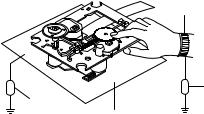
NOTES REGARDING COMPACT DISC PLAYER REPAIRS
1. Preparations
1)Compact disc players incorporate a great many ICs as well as the pick-up (laser diode). These components are sensitive to, and easily affected by, static electricity. If such static electricity is high voltage, components can be damaged, and for that reason components should be handled with care.
2)The pick-up is composed of many optical components and other high-precision components. Care must be taken, therefore, to avoid repair or storage where the temperature of humidity is high, where strong magnetism is present, or where there is excessive dust.
2. Notes for repair
1)Before replacing a component part, first disconnect the power supply lead wire from the unit
2)All equipment, measuring instruments and tools must be grounded.
3)The workbench should be covered with a conductive sheet and grounded.
When removing the laser pick-up from its conductive bag, do not place the pick-up on the bag. (This is because there is the possibility of damage by static electricity.)
4)To prevent AC leakage, the metal part of the soldering iron should be grounded.
5)Workers should be grounded by an armband (1M Ω)
6)Care should be taken not to permit the laser pick-up to come in contact with clothing, in order to prevent static electricity changes in the clothing to escape from the armband.
7)The laser beam from the pick-up should NEVER be directly facing the eyes or bare skin.
Armband
Resistor
(1 Mohm)
Resistor
(1 Mohm)
Conductive
Sheet
- 1-3 -

ESD PRECAUTIONS
Electrostatically Sensitive Devices (ESD)
Some semiconductor (solid state) devices can be damaged easily by static electricity. Such components commonly are called Electrostatically Sensitive Devices (ESD). Examples of typical ESD devices are integrated circuits and some field-effect transistors and semiconductor chip components. The following techniques should be used to help reduce the incidence of component damage caused by static electricity.
1.Immediately before handling any semiconductor component or semiconductor-equipped assembly, drain off any electrostatic charge on your body by touching a known earth ground. Alternatively, obtain and wear a commercially available discharging wrist strap device, which should be removed for potential shock reasons prior to applying power to the unit under test.
2.After removing an electrical assembly equipped with ESD devices, place the assembly on a conductive surface such as aluminum foil, to prevent electrostatic charge buildup or exposure of the assembly.
3.Use only a grounded-tip soldering iron to solder or unsolder ESD devices.
4.Use only an anti-static solder removal device. Some solder removal devices not classified as "anti-static" can generate electrical charges sufficient to damage ESD devices.
5.Do not use freon-propelled chemicals. These can generate electrical charges sufficient to damage ESD devices.
6.Do not remove a replacement ESD device from its protective package until immediately before you are ready to install it. (Most replacement ESD devices are packaged with leads electrically shorted together by conductive foam, aluminum foil or comparable conductive materials).
7.Immediately before removing the protective material from the leads of a replacement ESD device, touch the protective material to the chassis or circuit assembly into which the device will by installed.
CAUTION : BE SURE NO POWER IS APPLIED TO THE CHASSIS OR CIRCUIT, AND OBSERVE ALL OTHER SAFETY PRECAUTIONS.
8.Minimize bodily motions when handing unpackaged replacement ESD devices. (Otherwise harmless motion such as the brushing together of your clothes fabric or the lifting of your foot from a carpeted floor can generate static electricity sufficient to damage an ESD device).
CAUTION. GRAPHIC SYMBOLS
THE LIGHTNING FLASH WITH APROWHEAD SYMBOL. WITHIN AN EQUILATERAL TRIANGLE, IS INTENDED TO ALERT THE SERVICE PERSONNEL TO THE PRESENCE OF UNINSULATED “DANGEROUS VOLTAGE” THAT MAY BE OF SUFFICIENT MAGNITUDE TO CONSTITUTE A RISK OF ELECTRIC SHOCK.
THE EXCLAMATION POINT WITHIN AN EQUILATERAL TRIANGLE IS INTENDED TO ALERT THE SERVICE PERSONNEL TO THE PRESENCE OF IMPORTANT SAFETY INFORMATION IN SERVICE LITERATURE.
- 1-4 -

MEMO
- 1-6 -
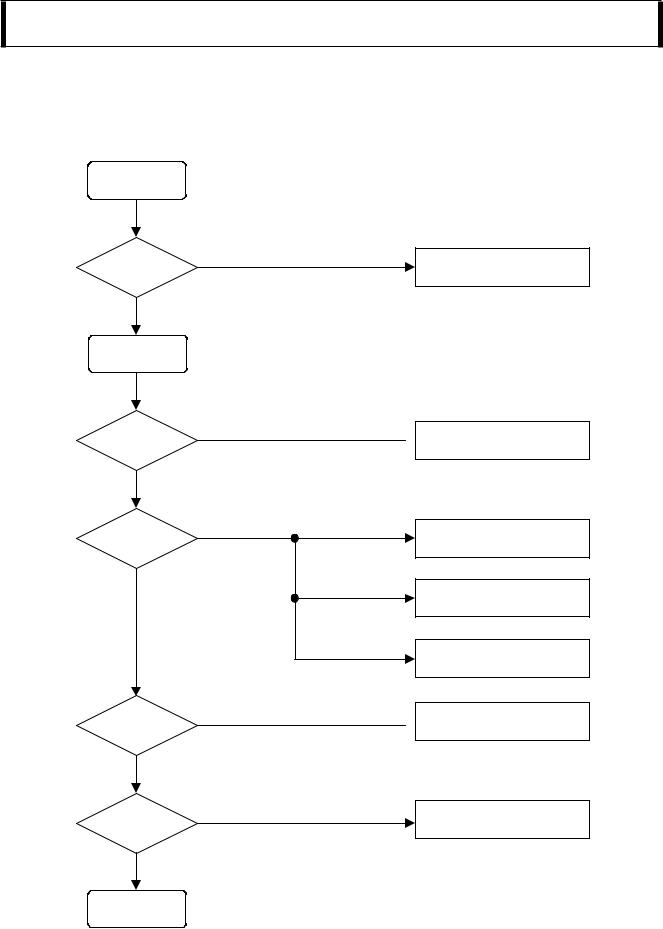
SECTION 2. AUDIO PART
ELECTRICAL TROUBLESHOOTING GUIDE
1.Power check flow
INSERT
POWER CORD.
TURN ON
THE RED LED?
YES
TURN POWER ON.
IS POWER ON?
YES
DOES INITIAL
READ WORK?
YES
DOES IT PLAY?
YES
DOES IT OUTPUT
AUDIO?
NO
NO
NO
NO
NO
CHECK POWER PLUG
AND POWER SUPPLY CIRCUIT.
 CHECK POWER SUPPLY CIRCUIT.
CHECK POWER SUPPLY CIRCUIT.
CHECK LASER CIRCUIT.
CHECK FOCUS CIRCUIT.
CHECK DISC.
 CHECK TRACKING SERVO CIRCUIT.
CHECK TRACKING SERVO CIRCUIT.
CHECK AUDIO CIRCUIT.
YES
OK
- 2-1 -
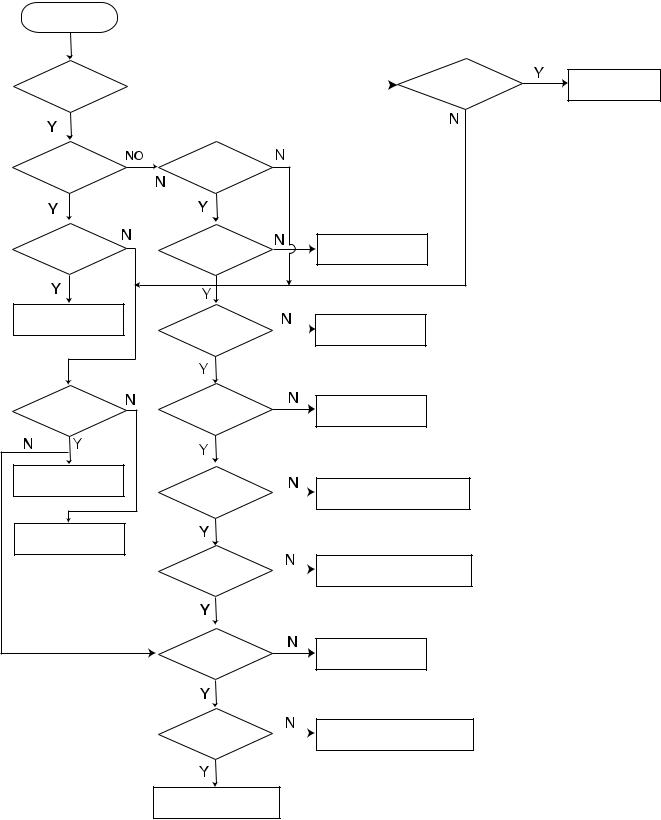
2.AUDIO µ.COM CIRCUIT
POWER ON
Does CD/DVD |
|
Does VIDEO 1/2, TV, AUDIO, |
OK. |
|
OPTICAL IN, COAXIAL IN, FM87.5 |
||
appear at FLT? |
|
||
|
appear at FLD? |
|
|
|
|
|
Does LOADING appear at FLD?
Does no Dise or |
Time appear at FLD? |
Check if DVD an Audio |
Micom Interface is OK. |
Does it appear |
|
DVD Error at |
|
FLD? |
|
Check |
|
Connector(PN902)if |
Reconnet it. |
is normally. |
|
Check power part |
|
Refer to SMPS |
of Main B/D. |
|
|
|
|
Check power. |
Check DVD Module. |
Check SMPS. |
Check oscillator |
Refer to oscillator |
|
of x101. |
||
Circuit. |
Check if IC101 |
|
Check DVD Reset Waveform. |
PIN1 is High. |
|
|
|
|
Check if IC101 |
|
Check IC101 Reset Wavefrom. |
PIN11 is High. |
|
|
|
|
Check if IC101 PIN
17, 46, 72, 90 is high Check 5V line. (5V).
Check if IC101 |
|
Check Power dection Circuit. |
PIN26 is High. |
|
|
|
|
Replace IC101.
- 2-2 -
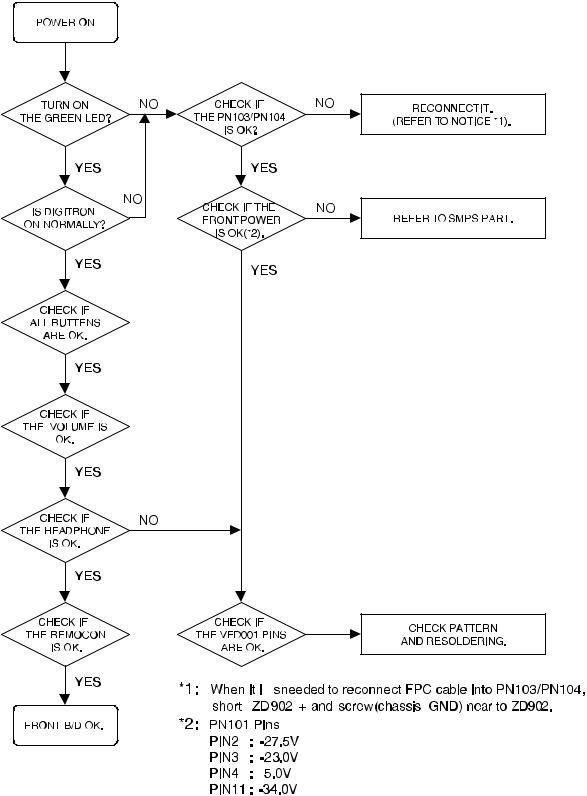
3.FRONT CIRCUIT (1/2)
- 2-3 -
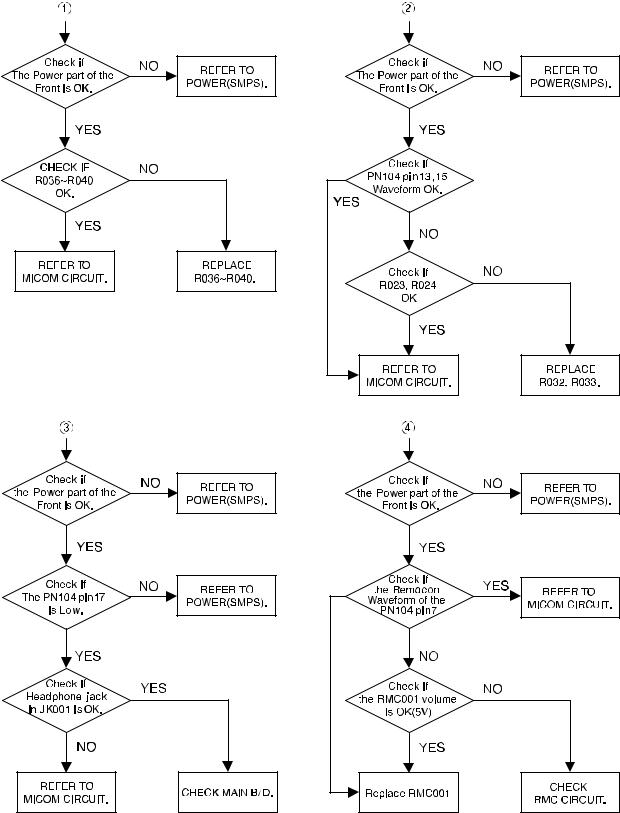
4.FRONT CIRCUIT (2/2)
- 2-4 -

SECTION 3. DVD PART ELECTRICAL TROUBLESHOOTING GUIDE
1. Power check flow
- 3-1 -

2. Test & debug flow
- 3-2 -
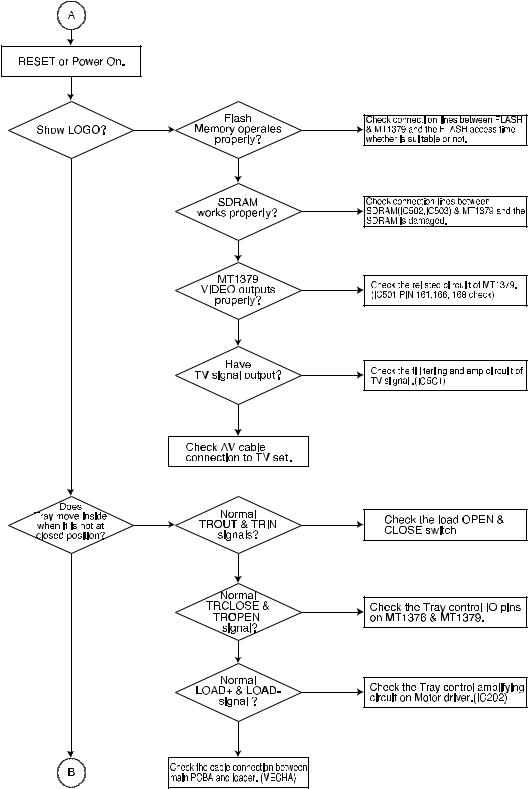
- 3-3 -
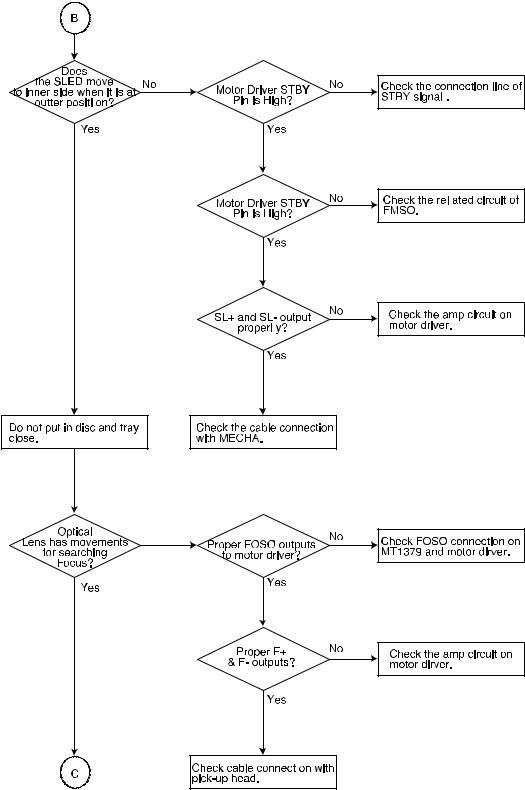
- 3-4 -
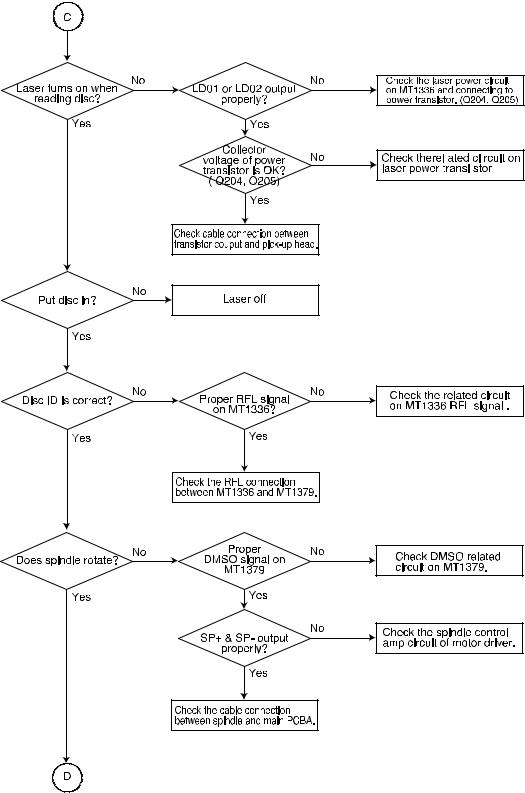
- 3-5 -
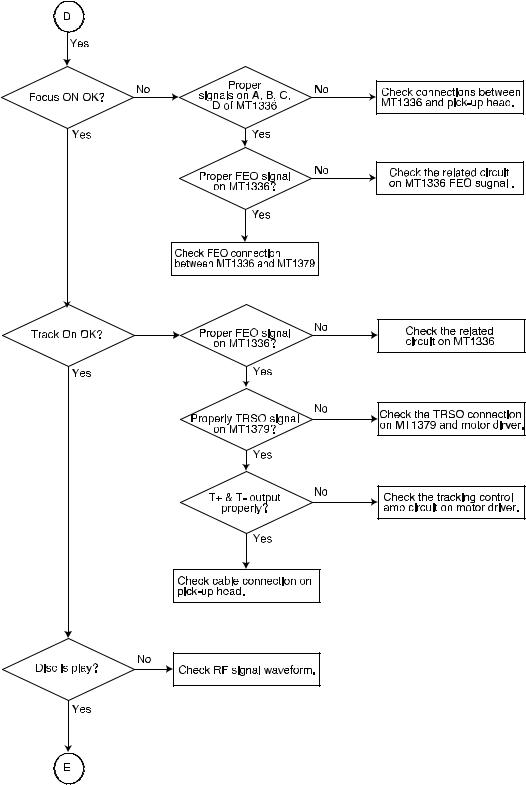
- 3-6 -
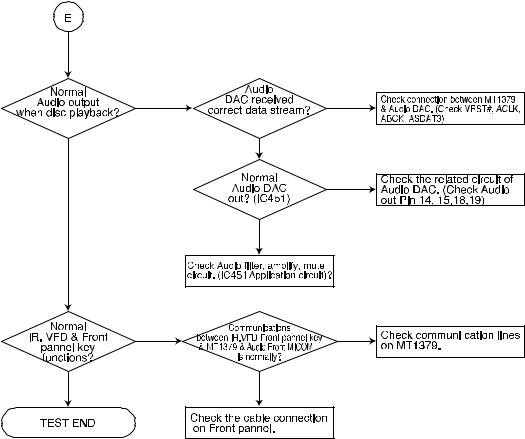
- 3-7 -
